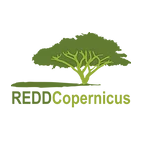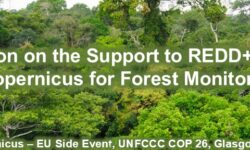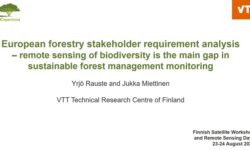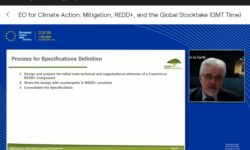One of the goals of the REDDCopernicus project is to identify and then prioritise the main research topics for Earth Observation of Sustainable Forest Management (SFM) in Europe. The increasing prominence of SFM in Europe affects the entire forestry sector including regulative bodies on EU and national level, private sector, non-governmental organizations and research community.
Aims
The ‘Earth Observation for European Sustainable Forest Management’ Webinar was organized to gather information on and discuss the requirements and current activities on Sustainable Forest Monitoring in Europe. The webinar was organised by the VTT Technical Research Centre of Finland, and it attracted 60 participants from EU and national government institutes, private sector, non-governmental organizations and associations as well as research community. The webinar provided forestry Stakeholders from different parts of Europe with an opportunity to share their views of SFM monitoring and learn about the latest developments in the topic.
Workshop Structure
The workshop was divided into four sessions including: 1) Introduction to Sustainable Forest Management (SFM) in Europe: 2) Government level activities; 3) Private sector approaches for SFM monitoring; and 4) Research activities on SFM monitoring. Each of the sessions consisted of presentations from key stakeholders and leading experts in the field and allowed discussion on the current issues on SFM monitoring. The agenda of the webinar is provided below, with links to the presentations.
1) Introduction to Sustainable Forest Management (SFM) in Europe
In the Introductions session, the UN Sustainable Development Goals were presented from the perspective of forestry and the Forest Europe sustainability criteria were introduced. The session included also presentation of the main results of an earlier DIABOLO project, which concentrated on field data harmonization across Europe. The session ended in presentation of preliminary results of the REDDCopernicus survey on SFM monitoring in Europe, which is designed to gather information on requirements and current practices in SFM monitoring among European forestry Stakeholders.
The preliminary results revealed:
- Nearly 90% of forestry Stakeholders are involved with SFM issues in some way.
- New approaches and products are needed especially for forest health and biodiversity monitoring.
- The usability of Earth Observation for biodiversity monitoring is doubted by many.
- Among the potential new products, forestry Stakeholders would most desire biotic and abiotic forest damage monitoring products.
2) Government level activities
The Government session included presentations from both European level organizations providing datasets and platforms in support of SFM monitoring as well as national institutes responsible for forest monitoring activities. Large variety of European level datasets and supporting analysis infrastructure for forest monitoring activities was highlighted. In addition, the crucial importance of National Forest Inventories (NFI) providing information for national and international reporting was emphasized. In many countries, remote sensing based approaches are already used by agencies responsible for fulfilling legislative monitoring and reporting requirements.
Sentinel 1 and 2 data were considered suitable for many monitoring needs, but with high temporal monitoring frequency (< 1 month), which is currently not supported by most Copernicus products.
3) Private sector approaches for SFM monitoring
The Private sector session provided perspectives and requirements from the Confederation of European Forest Owners (CEPF) and three forestry companies. It was revealed that the perspectives on and opportunities of SFM vary widely within Europe with different strengths, weaknesses, threats and opportunities in the Boreal, Temperate and Mediterranean forests. Private companies operating in Europe have increasing number of requirements related to SFM aspects. Particularly carbon (climate) and biodiversity aspects on SFM are gaining importance and requiring ever more efforts from forestry companies to fulfil reporting related to legislation, certification and consumer interaction. Remote sensing is already used to help fulfilling these requirements, but often with airborne data. Space-borne Earth Observation data was, however, considered to be potentially usable in providing transparent and comparable large area monitoring data, illustrating aspects of SFM to non-experts and building trust on responsible wood use.
4) Research activities on SFM monitoring
In the Research session, prominent experts on biodiversity, biomass, burnt area and forest disturbance monitoring presented the latest research developments. Clear potential for Earth Observation based SFM monitoring was identified e.g. for biotic and abiotic forest damage monitoring. At the same time, it was acknowledged that current Earth Observation data and methods cannot resolve e.g. many biodiversity related monitoring needs. There was also lively discussion on the reliability and credibility of European wide maps for national level analyses.
Results
Overall, the webinar highlighted the existence and usability of European wide criteria and indicators for Sustainable Forest Management. It is also clear that there is a strong demand for SFM monitoring in both government and private sectors. Furthermore, there are promising recent Earth Observation research results that may in future support operational SFM monitoring efforts. The REDDCopernicus project will continue its work aiming to identify the research efforts that would be most advantageous for the forestry Stakeholder community in the field of SFM.
Please find all presentations held at the workshop in the Downloads section



